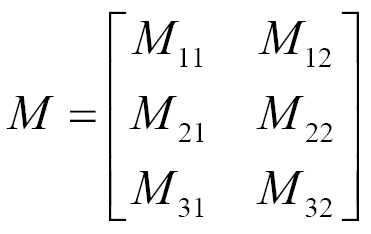A matrix is a  grid of numbers, represented by a bold capital letter. The number of rows in a matrix is represented by i; the number of columns is represented by j.
grid of numbers, represented by a bold capital letter. The number of rows in a matrix is represented by i; the number of columns is represented by j.
For example, in a 3 X 2 matrix, i would be 3 and j would be 2. This 3 X 2 matrix looks like this:

Matrices can be of any dimension; in video games, we tend to use 2 X 2, 3 X 3, and 4 X 4 matrices. If a matrix has the same number of rows and columns, it is called a square matrix. In this book, we're going to be working mostly with square matrices.
Individual elements of the matrix are indexed with subscripts. For example,  refers to the element in row 1, column 2 of the matrix M.
refers to the element in row 1, column 2 of the matrix M.
We are going to implement a 2 X 2, 3 X 3, and 4 X 4 matrix. Internally, each matrix will be represented as a linear array of memory. Much like vectors, we will use an anonymous union to support a variety of access patterns. Pay attention to how the indexing operator is overridden, matrix indices in code start at 0, not 1. This...

